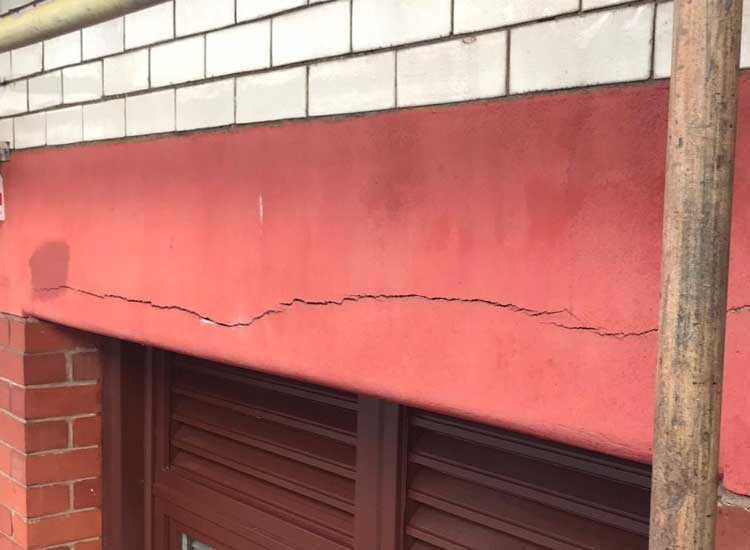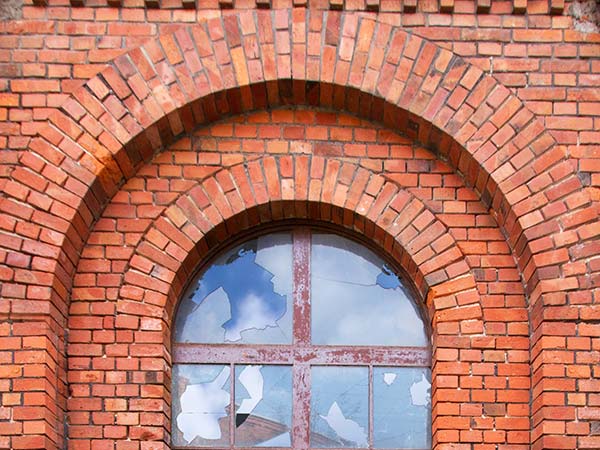Lintel Repair & Replacement

Have you noticed any cracks above your windows or doors? If so, this can be an alarming sign that one of your lintels have failed and requires lintel repair or replacement.
Lintels are structural support elements designed to carry the load from above openings such as doors and windows. Depending on the age of the property your lintels can be made of timber, bricks, steel, stone and most commonly concrete with steel rods.
Tired of reading? Listen to this article!
Even though most lintels can last decades, it is important to understand that rain and damp penetration eventually affects any fabric. Therefore, if you noticed any cracks, deterioration of the surface or signs of corrosion it is always a good idea to consult a professional to find out if your lintels continue to provide the intended support.
Modern lintel repair solutions are quick, cost-effective, and most importantly non-disruptive to the existing façade. If you have noticed any cracks surrounding windows or doors, then contact your local branch for advice or a property survey.
Why Do Lintels Fail?
Even though lintels are made of strong and durable materials, most of them will eventually require maintenance and repair. There are a few different reasons that can cause your lintels to crack and lose their structural integrity:
Natural deterioration
Adverse weather conditions and damp are continuously affecting the fabric of your property. As decades pass, materials used for lintels can start to corrode, expand, and rot, which naturally causes cracks and can reduce the strength of the lintel.
Foundation and wall
Shifting ground levels or changing water table can impact the building foundation. If for some reason the building foundation is altered, the wall above can lose its structural integrity. In cases like this, a lintel may need to hold a larger load than it was intended and this may eventually cause cracking. Cases like this are not isolated and also display cracks across the whole wall. If you notice similar symptoms, we would strongly recommend contacting a structural engineer to inspect your property.
Missing lintel
If you are looking for a lintel and cannot find it, that does not mean that the builder simply forgot to install it. Some older construction methods excluded lintels and used metal door and window frames for the same purpose. The problem occurs when the property owner decides to replace their old windows or doors with new UPVC units. If these newly installed units are then not supported with a lintel, then the brickwork above starts to pressure the opening. Units that are not designed to function as structural support elements then allow the brickwork to shift, which results in cracks and most importantly structural instability.
How to Spot a Faulty Lintel?
Sometimes you do not need to be a structural engineer to spot a faulty lintel. If you noticed any vertical or diagonal cracks above your windows or doors, this can be a strong indication that the lintel has failed. If your lintel supports a brick wall, the crack might appear diagonally from the corners of the opening.
If the masonry covering the lintel or the lintel itself starts to crumble, this can indicate expansion caused by rusting rods inside the lintel. It is important to know that in cases like this, lintel segments can crack and fall off becoming a serious safety hazard to anyone occupying the space below.
Repairing Different Types of Lintels
Brick Lintel Repair
Traditional brick lintels and brick arch lintels are typically repaired using a remedial steel bar system. The structure of these lintels is repaired by removing strategically selected segments of the pointing and inserting remedial treatment bars across the length of the lintel. The brick arch lintel may also require to be pinned in position. These segments are then repointed making the whole repair practically invisible.

Concrete Lintel Repair
Concrete lintels are typically reinforced with steel rods. While these rods increase strength of the lintel, in some cases it can also contribute to its failure. As concrete is penetrated by rainwater, steel rods can start to corrode and expand, causing the lintel to crack as a result.
Cases such as this are typically repaired using our concrete lintel repair system. This system involves removing the cracked section of the lintel, brushing, and grinding the rust from the steel rods and reshaping the lintel using a fast-curing concrete solution. Typically, this type of lintel repair can be completed within the same day as the repair concrete sets and cures quickly.
Metal Lintel Repair
As in the previous case, damp affected metal elements eventually start to corrode. As corrosion appears the lintel expands, causing the surrounding masonry to crack. Cases like this can be repaired either by supplementing the existing lintel or replacing the existing lintel. The brickwork above the lintel may require stabilisation as noted above.
Timber Lintel Repair
Most older properties can still contain lintels made of timber. If preserved properly, timber lintels can serve just as long as steel or concrete alternatives. Unfortunately, if affected by damp, timber lintels may be affected by a wood destroying fungal attack or even attract wood-boring insects, both negatively affecting the strength of the lintel.
If your timber lintels have failed, this does not mean that you require to completely replace them with steel or concrete alternatives. Here at Richardson & Starling, we offer structural repair solutions that repair such lintels using our resin and steel rod repair system should this is the best and most cost-effective solution to deal with the lintel problem.
Remedial Lintel Repairs
Many structural defects such as lintel failures do not require significant disruption to repair the issue. Here at Richardson & Starling, we strive to provide minimal-disruptive and cost-effective repair solutions that make minimal to no visual impact on the exterior of the property.
We use modern remedial repair systems that work by inserting strong metal rods into mortar joints that later function as support beams. The process involves grinding slots into the affected areas mortar beds then 2 stainless steel rods are inserted. The gap is then filled with a special cementitious anchor grout and this reinforces and stabilises the damaged masonry and lintel. This effectively creates a masonry beam which has an excellent load-bearing capacity and is fully capable to support the brickwork above.
Lintel Defect Survey
Our property preservation surveyors will investigate the scale as well as the cause of your problem. At Richardson & Starling, we only supply experienced surveyors who are highly trained in all types of structural and damp related property defects. This means that our surveyor will be able to complete the survey and give the appropriate remedial recommendations and a quotation for the appropriate remedial works.

Submit a picture of the affected lintel for a free evaluation. Simply fill a quick form, add your image and one of our experienced surveyors will share their observations and advice free of charge.
